|
|
Post by Deleted on Jan 24, 2017 15:53:43 GMT -5
From 1948-1972 Dell/Gold Key held the rights to publish ERB's Tarzan. They published 206 issues. They featured some awesome art by Jesse Marsh & Russ Manning. Then in 1972 DC received the rights to publish Tarzan.
Carmine Infantino was publisher at that time & approached Joe Kubert (editor of DC's war books) about doing Tarzan for DC. Kubert was a big fan of Tarzan & jumped at the chance. In the intro to the collection published by Dark Horse Kubert elaborates: To prepare he re-read all of ERB's Tarzan novels. He studied Hal Foster's work on the newspaper comic strips. And then he wrote, penciled, inked, lettered & edited Tarzan #207-235.
Kubert would stay on the book as writer/editor until #249. The last DC issue was #258. Then ERB gave the rights to Marvel who had Roy Thomas & John Buscema create some great Tarzan stories. They had brought REH Conan to life in comic books. Maybe someday I will review that run...
My reviews will be from the Dark Horse collection ERB's Tarzan The Complete Joe Kubert Years. I no longer have all of my original copies of Tarzan so I will only be commenting on the Tarzan stories & not the back ups that were also in the issues. |
|
|
|
Post by Slam_Bradley on Jan 24, 2017 16:23:44 GMT -5
I have the original issues. I may attempt to play along. Though I have a very short attention span.
|
|
|
|
Post by Deleted on Jan 24, 2017 16:24:39 GMT -5
 Joe Kubert starts DC's Tarzan by adapting ERB first novel & retelling Tarzan's origin. Look at the cover. This is a different Tarzan than we have seen at Gold Key. This Tarzan is more primal & visceral. Kubert's sketchy art style fits Tarzan perfectly. His Tarzan is lean, muscular & looks battle scarred. His art explodes with action. A lady is guided thru the African jungle by Klaxton to find her missing father. They are attacked by a panther & Tarzan comes to their rescue. 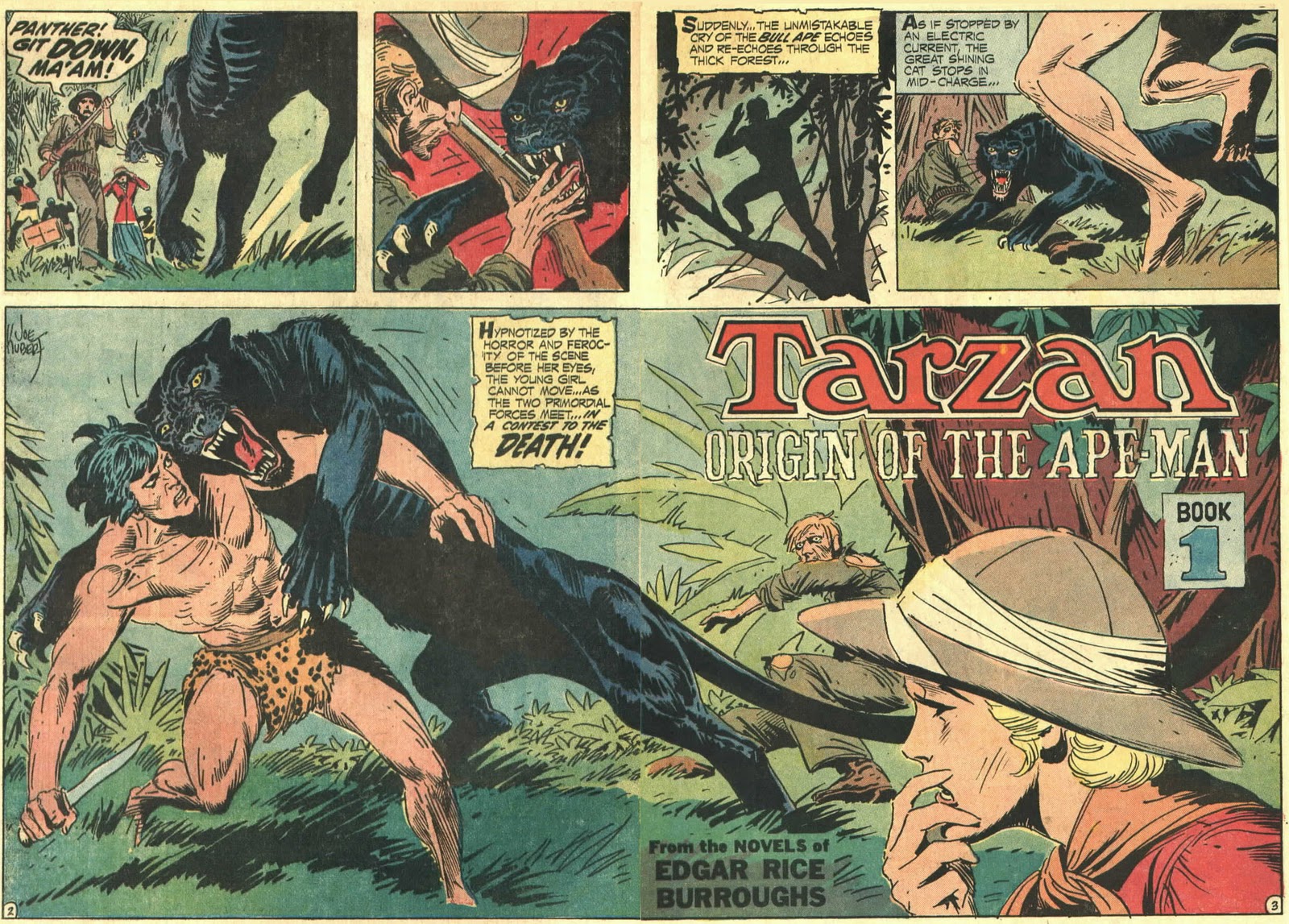 The lady is stunned & Klaxton begins the tale of an ape man that lives in the jungle. In 1888 John Clayton Lord Greystoke & his wife Lady Alice are sent to Africa by the Queen for England. The crew of the ship mutiny & leave them marooned on the coast of Africa with some supplies. John builds a cabin & they learn to survive in this new environment. Months later Lady Alice gives birth to a boy & dies one year later. Meanwhile Kerchak the leader of the apes goes on a rampage & Kala's baby is killed. The apes find their way to the cabin & kill Clayton. Kala puts her dead baby in the crib & takes the human baby as her own. She names him Tarzan (white skin in the ape language) & raises him as her own. As he grows he laments that he doesn't look like the others but discovers being human gives him other "abilities" the apes do not have like swimming. When he turns 13 he explores the cabin. He discovers books with pictures of humans. He also finds a knife. He gets into a fight with Bolgani a rival bull ape & kills him with the knife. The rest of the apes are stunned that puny Tarzan could kill Bolgani. Kala tends his wounds.... 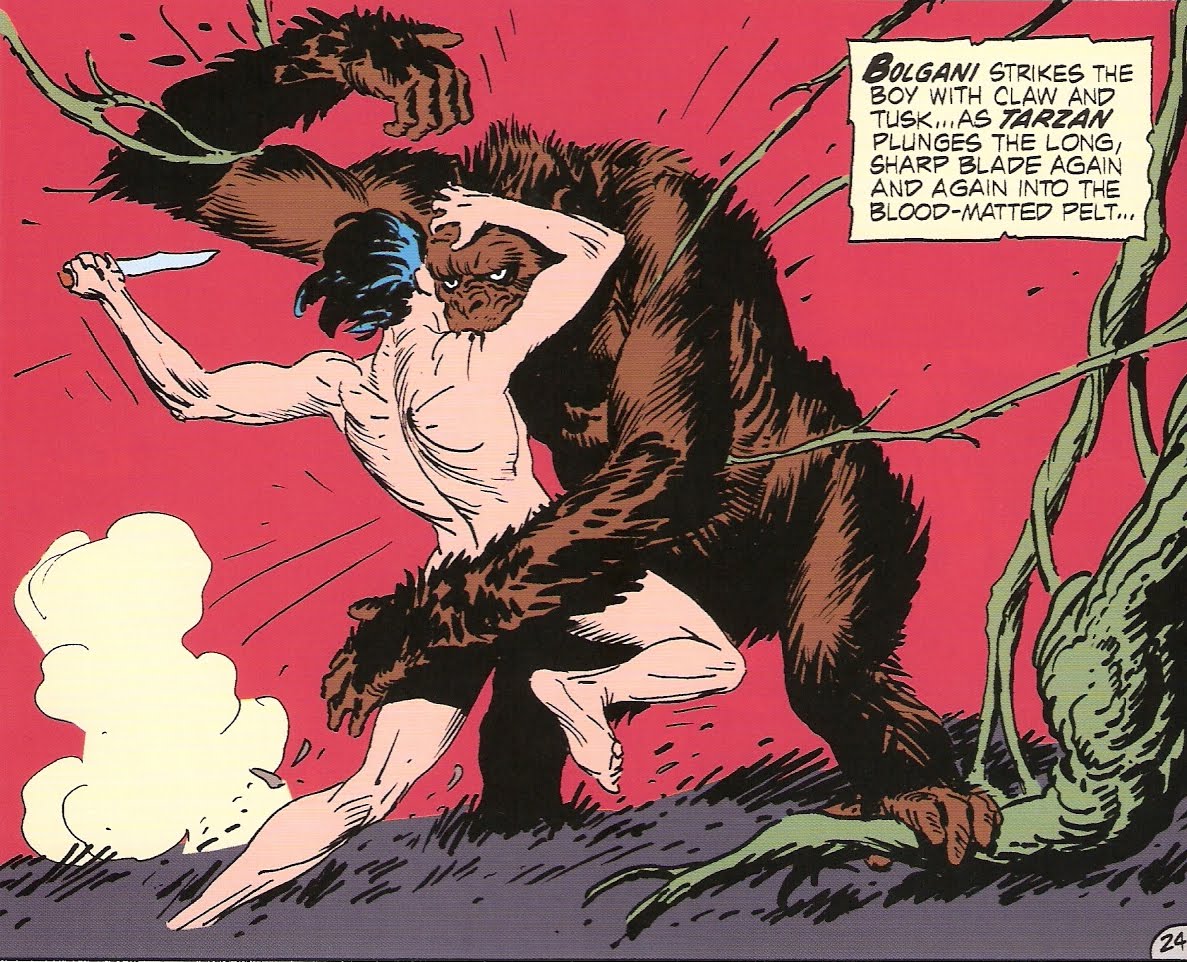 To Be Continued. |
|
|
|
Post by Deleted on Jan 24, 2017 16:31:49 GMT -5
The story is familiar. I knew Tarzan's origin. I had read the novel. I had seen Tarzan in movies & on TV. I think Kubert did an excellent job adapting it into a comic book. He is an excellent storyteller IMO. His art is perfect for Tarzan. It isn't polished. It is raw & explosive. It is detailed but yet simple at the same time. I remember eagerly awaiting the next issue back in the 70's.
|
|
|
|
Post by Slam_Bradley on Jan 24, 2017 16:40:23 GMT -5
Without re-reading the issue, though I've read it in the last couple of years, the striking thing about Kubert's Tarzan is that it feels...gritty. There's a sense of musty jungle-ness that was absolutely not there in the Dell/Gold Key issues. The jungle seems oppressive and hot. Tarzan looks just a bit dirty and the people seem to feel the heat and the humidity of their surroundings. The animals seem appropriately feral and you can imagine how they smell.
|
|
|
|
Post by codystarbuck on Jan 25, 2017 2:51:47 GMT -5
Kubert was so perfect for this, with his style conveying that primal atmosphere.
When I was resigning my naval commission, I applied to the Kubert School and went up there for my interview (with instructor Mike Chen). My interview was in the school library, where there was a large painting of Tarzan fighting a crocodile, in a river, by Kubert. While Chen looked over my portfolio, I stared up at that thing, intimidated as all hell. My stuff looked like children's drawings, by comparison.
|
|
|
|
Post by brutalis on Jan 25, 2017 8:39:35 GMT -5
That cover is just so perfect in capturing the essence and spirit of Tarzan. I had this lone issue without it's cover from trading with a neighbor across the alley when i was a child. It being the only Kubert Tarzan i ever saw other than in house ads in other DC comics of the time. But boy did i want them. This was at a time just before i was old enough to having money and affording comic books on a regular basis. And then when that newly aborning thing called the comic book store burst forth these were always highly sought after expensive collectible issues and the stores here in town had but few odd issues too highly priced for my budget.
Kubert's Tarzan was lithe, limber, powerful and athletic in ways the movies and television shows never could be. There was a primitive primordial strength envisioned by Kubert's Tarzan which now i can truly appreciate, savor and recognize in Tarzan as a true Lord of the Jungle.
|
|
|
|
Post by Deleted on Jan 27, 2017 10:25:49 GMT -5
 Part 2 of Tarzan's origin. After he heals from his fight Tarzan celebrates with the apes his victory. However Tublat is jealous & Tarzan has another fight & kills Tublat with his knife. He continues to go back to the cabin & learns to read from books with pictures. He discovers he is a man not an ape. He decides to wear clothing like the men he sees in the pictures. He attempts to kill a lioness to make a furskin but he doesn't succeed. He is starting to feel more alone after the other apes have mates but he has none. He escapes to the cabin & discovers woman in the books. Tarzan hopes to find one someday. Later Kala is killed by an arrow from Kulonga (who is from a nearby tribe). Tarzan tracks him, kills him & takes his clothing & weapons. He then goes to Kulonga's village & steals more arrows. Later he kills the lioness & Kerchak becomes jealous that Tarzan has become so powerful. 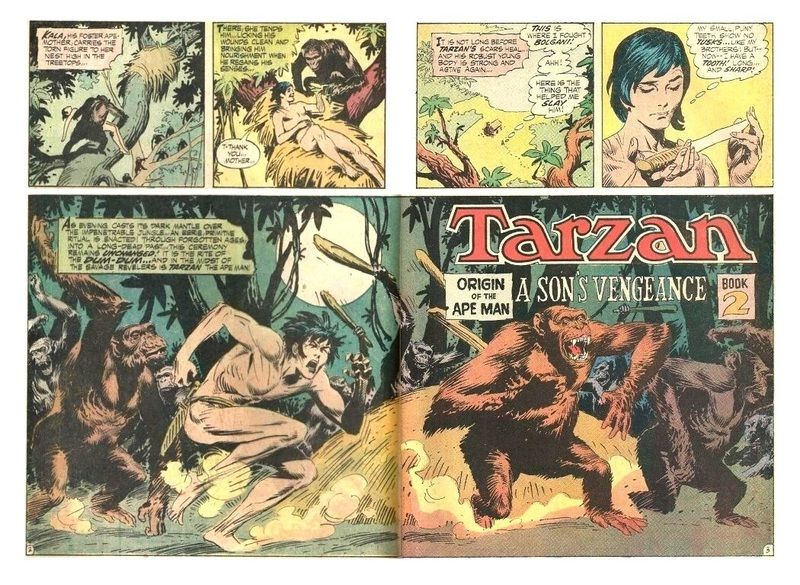   |
|
|
|
Post by Deleted on Jan 27, 2017 10:36:45 GMT -5
Kubert continues his adaption of Tarzan's origin. One thing I was surprised about re-reading it was how violent it was for the time it was printed. A lot of killing took place. I was wondering how the CCA approved it. Another point Tarzan desired a female ape as a mate in a short sequence. I remember when I first read it as a teen feeling repulsed. As an adult I was surprised that this scene was allowed. It was implying something disturbing.
The story was good. Kubert shows Tarzan growing into his late teens & how he is becoming a legend in the jungle. It explains why he wears a loincloth. How he acquired weapons, learned to read. And his art is vibrant, raw, explosive. Kubert was truly one of the masters of this art form.
|
|
|
|
Post by codystarbuck on Jan 27, 2017 12:04:22 GMT -5
Sometimes I think the CCA let things pass because they didn't perceive them the same as the superhero comics. With Tarzan, it had been a long standing newspaper strip. I wouldn't be surprised if they rubber stamped it, figuring that if it was okay for newspapers, it was okay for comics. Also, it was a literary adaptation, so it was ranked higher by them. Just a theory. It also seems that the CCA's teeth had become loosened, after the 60s and it wasn't to long before the code was revised, leading to the explosion of horror titles that followed.
|
|
|
|
Post by brutalis on Jan 27, 2017 13:23:31 GMT -5
Kubert continues his adaption of Tarzan's origin. One thing I was surprised about re-reading it was how violent it was for the time it was printed. A lot of killing took place. I was wondering how the CCA approved it. Another point Tarzan desired a female ape as a mate in a short sequence. I remember when I first read it as a teen feeling repulsed. As an adult I was surprised that this scene was allowed. It was implying something disturbing. The story was good. Kubert shows Tarzan growing into his late teens & how he is becoming a legend in the jungle. It explains why he wears a loincloth. How he acquired weapons, learned to read. And his art is vibrant, raw, explosive. Kubert was truly one of the masters of this art form. Having only read this recently the fact of showing Tarzan desiring a female ape was part of the evolution and growth in showing Tarzan didn't understand his difference from the apes and thought of himself as an ape. It also underscored his love for his mother Kala the she-ape being a natural emotion. As his learning to read and write eventually teaches him the differences between man and ape and many of the similarities. Yet if reading this a youngster or teen it would appear to be downright eerie. |
|
|
|
Post by Slam_Bradley on Jan 27, 2017 13:30:00 GMT -5
Kubert continues his adaption of Tarzan's origin. One thing I was surprised about re-reading it was how violent it was for the time it was printed. A lot of killing took place. I was wondering how the CCA approved it. Another point Tarzan desired a female ape as a mate in a short sequence. I remember when I first read it as a teen feeling repulsed. As an adult I was surprised that this scene was allowed. It was implying something disturbing. The story was good. Kubert shows Tarzan growing into his late teens & how he is becoming a legend in the jungle. It explains why he wears a loincloth. How he acquired weapons, learned to read. And his art is vibrant, raw, explosive. Kubert was truly one of the masters of this art form. Having only read this recently the fact of showing Tarzan desiring a female ape was part of the evolution and growth in showing Tarzan didn't understand his difference from the apes and thought of himself as an ape. It also underscored his love for his mother Kala the she-ape being a natural emotion. As his learning to read and write eventually teaches him the differences between man and ape and many of the similarities. Yet if reading this a youngster or teen it would appear to be downright eerie. Exactly. Tarzan was, as far as he was concerned and knew, an ape. The only love he ever got was from Kala. He was around apes all the time and just thought of himself as "The Ugly Apeling". It is really perfectly natural for him to desire a female ape. |
|
|
|
Post by Deleted on Jan 27, 2017 13:47:15 GMT -5
Having only read this recently the fact of showing Tarzan desiring a female ape was part of the evolution and growth in showing Tarzan didn't understand his difference from the apes and thought of himself as an ape. It also underscored his love for his mother Kala the she-ape being a natural emotion. As his learning to read and write eventually teaches him the differences between man and ape and many of the similarities. Yet if reading this a youngster or teen it would appear to be downright eerie. Exactly what I was trying to say. When I write these reviews I really try to recall what I felt when I was reading them for the first time. When I read this in my early teen years I was disturbed & disgusted. If this was in the novel I don't recall it because I read that when I was much younger. As an adult I get it. It made sense. I thought Kubert handled it well. I also wonder how the CCA saw it. |
|
|
|
Post by brutalis on Jan 27, 2017 14:03:38 GMT -5
Having only read this recently the fact of showing Tarzan desiring a female ape was part of the evolution and growth in showing Tarzan didn't understand his difference from the apes and thought of himself as an ape. It also underscored his love for his mother Kala the she-ape being a natural emotion. As his learning to read and write eventually teaches him the differences between man and ape and many of the similarities. Yet if reading this a youngster or teen it would appear to be downright eerie. Exactly what I was trying to say. When I write these reviews I really try to recall what I felt when I was reading them for the first time. When I read this in my early teen years I was disturbed & disgusted. If this was in the novel I don't recall it because I read that when I was much younger. As an adult I get it. It made sense. I thought Kubert handled it well. I also wonder how the CCA saw it. Having just read the 1st Tarzan novel before the holiday's and into the 2nd novel i haven't read anything in either of them suggesting such. If anything Tarzan being more ape than man is actually explored from the eyes of the human's he interacts with and Tarzan himself notes more often than not on how apes and the animals are more "humane" than man. |
|
|
|
Post by Deleted on Jan 30, 2017 22:18:53 GMT -5
 As Tarzan grows into manhood tension & jealousy build among the apes. Kerchak & Tarzan fight & Tarzan kills Kerchak. Then Terkoz challenges Tarzan to a fight without Tarzan using his knife. Tarzan prevails & bans Terkoz from the tribe. 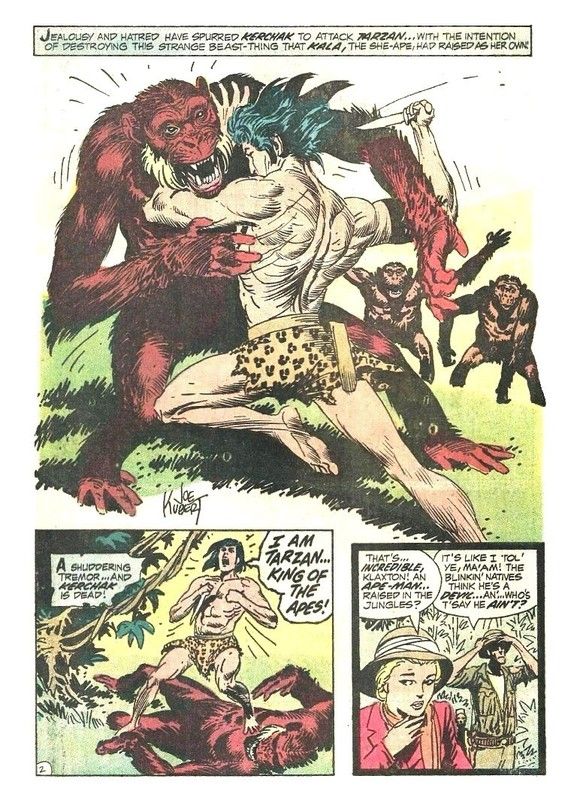 Tarzan observes a landing party near his cabin. Among them is Jane Porter. Tarzan observes them from a distance. He protects them from the dangers of the jungle. He sees the landing party burying treasure & digs it up & hides it. Meanwhile Terkoz captures Jane & Tarzan kills Terkoz & rescues Jane. 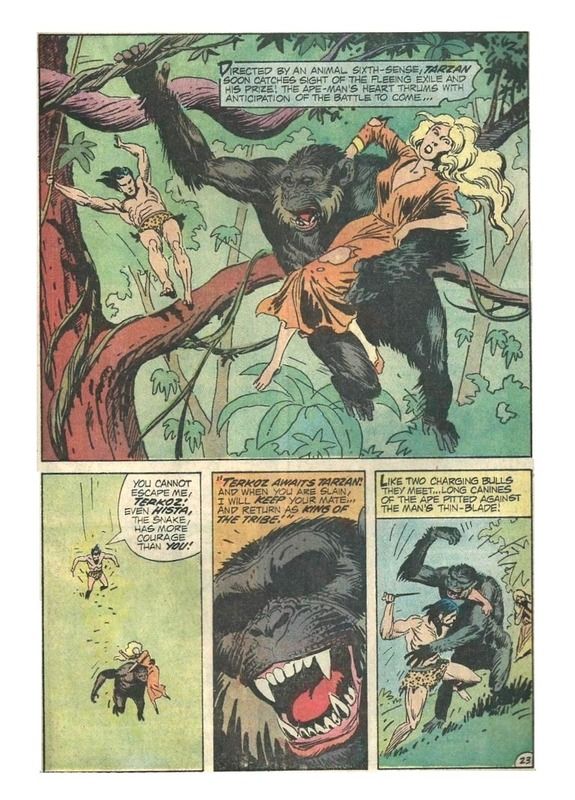 End of part 3. |
|